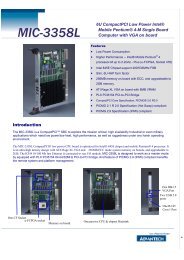industrial wireless book special edition - Networking ...
industrial wireless book special edition - Networking ...
industrial wireless book special edition - Networking ...
Create successful ePaper yourself
Turn your PDF publications into a flip-book with our unique Google optimized e-Paper software.
60GHz Industrial Wireless:<br />
perfect for point-to-point<br />
Radio systems operating in the licence-free 60GHz band – yes there is one – have characteristics that make<br />
them significantly different from the more familiar hardware operating at the traditional 2.4 and 5GHz ISM<br />
frequencies. These altered qualities give 60GHz millimetric wavelength radios operational advantages not<br />
found in other <strong>wireless</strong> systems. For instance it is possible to achieve orders of magnitude higher link<br />
budgets than those possible with IEEE 802.11n and Ultra Wideband (UWB) systems – which translates into<br />
reliable and affordable <strong>wireless</strong> connections. Frank Ogden reports<br />
THERE ARE OCCASIONS when network cabling media characteristics: the necessary patch<br />
antennas are both physically small and highly<br />
directional while oxygen spectral absorption<br />
restricts path length to about 1.6km. And of<br />
course the signal path must be entirely line<br />
of sight for the link to operate. Against this,<br />
the highly directional antennas make the signal<br />
– a beam – almost impossible to intercept and<br />
virtually immune to interference, either from<br />
all the usual <strong>industrial</strong> sources of EMI or from<br />
other inhabitants of the crowded lower<br />
frequency ISM bands. Other 60GHz operations<br />
just can’t do the job and the practical alternative<br />
is <strong>wireless</strong> Ethernet. Most <strong>industrial</strong> transmissions only ‘illuminate’ what they point<br />
are unlikely to interfere since narrow beam<br />
applications can be adequately served by at and, in any case, oxygen signal attenuation<br />
IEEE802.11a/b/g/n WLAN hardware operating places a limit on interference from distant<br />
at 2.4 or 5GHz, certainly where the link distance sources.<br />
is no more than a couple of hundred metres. When it comes to possible data bandwidth,<br />
Beyond this span, office-style <strong>wireless</strong> installation<br />
gets a bit more problematic with both 100 times wider than the channel bandwidth<br />
the RF baseband is 7GHz wide – getting on for<br />
performance and security concerns. If the link available under 5GHz ISM band operation. There<br />
requirement is fixed point-to-point, then 60GHz is already plug and play 60GHz COTS hardware<br />
operation might be an alternative.<br />
on the market which delivers true 100Mbps Fast<br />
With its own licence-free operational Ethernet full duplex performance but the<br />
frequency allocation just like existing ISM, it potential data bandwidth achievable is much<br />
is possible to set up and operate 60G fixed links greater, limited only by the confines of<br />
to implement a plug and play extension to a Shannon’s Law.<br />
network without wires. Of course a millimetric Possible <strong>industrial</strong> applications include all<br />
operational frequency brings with it specific those where one might presently use multimode<br />
optical fibre media but are precluded because<br />
a cable might get in the way, or otherwise be<br />
difficult or expensive to install. For instance,<br />
When you can’t dig up the road, this 60GHz <strong>wireless</strong><br />
bridge from Huber & Suhner implements a useful<br />
Ethernet-based line-of-sight <strong>wireless</strong> solution…<br />
sponsored by Advantech<br />
PHOTO: HUBER & SUHNER PHOTO: HUBER & SUHNER<br />
<strong>industrial</strong> ethernet <strong>book</strong><br />
Airbus explores 60GHz for <strong>wireless</strong> IFE, WAIC<br />
a 60G fixed link would be perfect for connecting<br />
up buildings separated by public roads, implementing<br />
low installation effort temporary links<br />
around tank farms and utilities and similar. Away<br />
from <strong>industrial</strong> plant, 60G is receiving serious<br />
interest for ‘last mile’ telecoms distribution,<br />
cellular backhaul and data centre connections,<br />
in fact anywhere which needs flexible, noninvasive<br />
point-to-point network segments.<br />
Friis’ Law is good!<br />
The high antenna gain typical for 60GHz<br />
systems comes in part from the Friis Equation<br />
for Path Loss. This equation, also known as<br />
Friis’ Law, holds that as the frequency of<br />
operation changes, the effective area of any<br />
particular antenna varies proportionately to the<br />
square of the operational frequency. Put<br />
another way, this means that the gain possible<br />
from an antenna of any given size increases by<br />
the operational frequency squared. An antenna<br />
with an area of of just over 6cm 2 – a square an<br />
inch on a side – will have a gain of approximately<br />
25dBi at 60GHz versus a gain of<br />
approximately 3dBi at 5GHz. This characteristic<br />
provides the mechanism by which millimetre<br />
wave systems deliver better link budget performance<br />
than systems operating at lower<br />
frequencies.<br />
First published in the <strong>industrial</strong> ethernet <strong>book</strong> February<br />
2011<br />
The Fraunhofer-Heinrich Hertz Institute in Berlin has carried out several projects with Airbus in the use<br />
of 60GHz technology for <strong>wireless</strong> in-flight entertainment as well as low rate WAIC (Wireless Avionics<br />
Intra-Communications) at lower frequencies for sensor and crew communication applications.<br />
The basic idea of <strong>wireless</strong> onboard communication is to replace wired infrastructure by <strong>wireless</strong> links.<br />
The applications range from traditional in-cabin connections such as crew communication through new<br />
passenger services, and individual in-flight entertainment to use in sensor networks with hundreds<br />
of sensor nodes inside the whole aircraft structure. The motivation for these developments include the<br />
saving of weight and wiring harness maintenance, the higher robustness of a self organised <strong>wireless</strong><br />
networks compared to wires and connectors, higher flexibility in cabin configurations, and the<br />
implementation of new functions such as sensors at moving or non-accessible parts.<br />
The 60GHz frequency band is a most promising candidate. It provides several gigahertz of bandwidth<br />
for license-free worldwide use, and the high free space attenuation minimises interferences between<br />
different aircrafts and allows a reuse of frequencies, even within the same cabin.<br />
Similar work is presently being done at Boeing, mainly in the use of WiFi, but 60GHz is also under<br />
investigation by the US plane maker.<br />
Dr.-Ing. Wilhelm Keusgen<br />
<strong>industrial</strong> <strong>wireless</strong><br />
51

















